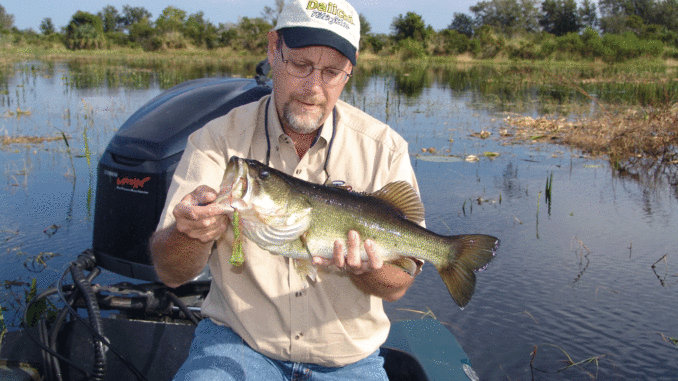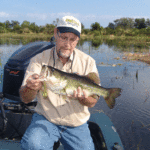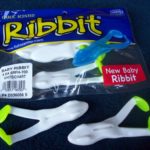
This little bait making a big splash
A Pineville bass fisherman was an unhappy camper one afternoon the first week of October while fishing Toledo Bend.
Dusty Anders, 44, a veteran Alexandria firefighter, and his bass fishing buddy were fresh out of watermelon red/pearl Ribbits. Specifically, Baby Ribbits, which had been out on the market all of three weeks, had been the rage of the day, especially early that day on the lake that is oh-so low.
“We threw it this morning for a while and caught on the same ol’ color — watermelon red/pearl. Well, we’ve run out of frogs. We don’t have any more of that color,” Anders said, his sentences interrupted by the strike of a bass, his hookset and catch of a chunky fish.
Sure, Anders said, they still caught on other-colored Baby Ribbits (white and baby bass). But his confidence color combination for so many years was gone for the time being, perhaps until the next time he met up with Ribbit creator John Dean of Many, his bass fishing partner on the Bass ’N’ Bucks pro bass fishing tournament trail, who just recently added the Baby Ribbit to the line of soft-plastic frogs so popular in and around Louisiana.
Anders said he fishes the Baby Ribbit on a 3/0 weighted hook, which gives the lighter soft plastic a little more oomph on the cast and acts as a “keel” to keep the plastic frog’s belly down on the retrieve. He was impressed with the smaller version (3 inches long) of the basic 4-inch-long Ribbit.
“It’s definitely got its place,” Anders said while probing in and around the grass beds in Lowe’s Bay. “Sometimes they’ll hit the big ones, knock it out of the water and miss.
“They’re taking it (Baby Ribbit) pretty good. When it slicks off, you need something a little more subtle.”
How effective? Anders said on his first cast of the morning he hooked up with a bass that bit on the little plastic frog before he could turn the handle.
That was the idea in the downsizing process, Dean said. The manufacturer’s smaller-profile frog has a different sound to it when it is retrieved across the surface.
“What I’ve come up with is a little different pitch and a little more subtle as far as water displacement,” Dean said. “It’s a finessing bait. When you don’t want a lot of noise, when you don’t want a lot of water displacement, we’ve covered that. We’ve got that type of bait.”
But it wasn’t wine and roses during the early stages of its evolution.
“When I started to downsize to 3 inches, I immediately realized ‘you got a hook issue,’” said Dean. “You can’t go too small (on the soft-plastic frog’s body), but you’ve got to go small enough where it’s recognizable that it’s smaller.
“I had to target somewhere around a 3/0 hook. I had to find a happy medium. That was a tough nut to crack. That Baby Ribbit took a while. I went through several prototypes.”
True. He anxiously talked to keep me up-to-date for the last five or six months before its release about the downsizing project he was working on. He described the steps, the triumphs and the headaches on his latest idea to give the bassin’ public another option.
Dean said a 4/0 Double Take hook — designed especially for the company’s bogus frogs to increase the strike/catch ratio with two hook points, one for each leg — also fits the Baby Ribbit. But it’s a tight fit, said Anders, who really prefers a 3/0 weighted hook.
The original Ribbit, which made its debut almost one decade ago, is a 4-inch-long soft-plastic frog with distinctively designed “feet” that create realistic kicking action, much like the motion of a live hopper jumping across the surface. The fact that it is virtually weedless makes it even more popular.
Dean, however, strived for more. He always has been thinking ahead after the original Ribbit.
“With as many fish as its caught over the years, you think, ‘What can I do different with the project?’” he said. “The first request (from bass anglers) was for a bigger one, which we call a Bull Ribbit, a bulkier bait which doesn’t get as many bites, but bigger bites.”
After that, the company churned out other Ribbits.
“Each little thing I’ve tried to do with the basic Ribbit has been a success,” Dean said as he ticked off the succession of bogus frogs that have slayed the bass from coast to coast — Ribbit, Bull Ribbit, Ribbit Floater, Ribbit Hot Feet and Ribbit Buzzit. The latter was an interesting approach with a buzz bait appearance.
There’s a good reason Ribbits have done so well on the water, according to widely known artificial lure manufacture Lonnie Stanley, a five-time Bassmaster Classic qualifer who owns Stanley Lures.
“Frogs are one of the primary forage species for largemouth bass and many other fish,” Stanley said. “If a bass could order its food off a menu, it would probably pick crawfish first, frogs second and shad or bream third.
“Frogs give bass plenty of protein.”
Dean realizes his newest product was hitting the shelves during the heart of the hunting season, mostly for ducks and deer, coming up.
“It may not be a good time to introduce a bait out there … but we know they’ll come out strong,” said Dean. “The Baby Ribbit will have its place.
“It’s going to be a dominant little bait.”
For more information, go to www.fishstanley.com.

